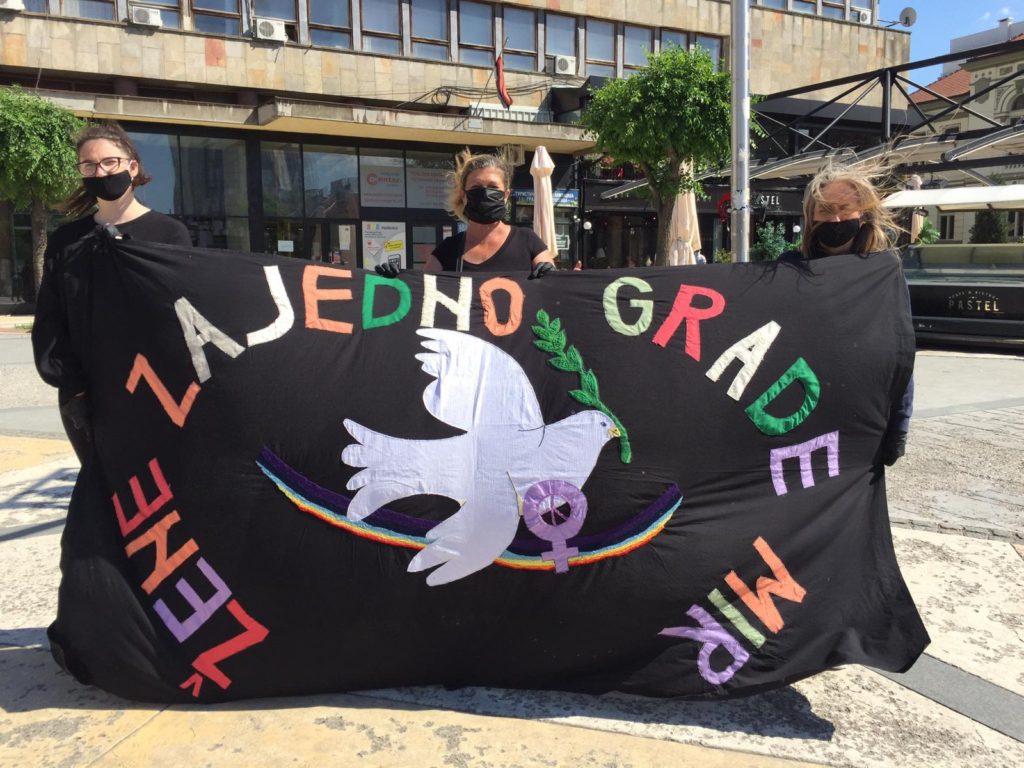
“We talked about personal security when drafting the National Action Plan (NAP), but what we actually mean with NAP is to engage women in national security issues. Let us put women in the military and things will change.”
Dragana Petrovic,
former member and initiator of Gender Equality council,
gender advisor for the drafting of NAP 1325
____________
INTRODUCTION: A DOUBLE ANNIVERSARY
This year the world celebrates the twentieth anniversary of United Nations Security Council Resolution (UNSCR) 1325, but it also marks the tenth anniversary of the first Serbian National Action Plan (NAP). Thus 2020 represents an important landmark for the Women, Peace and Security Agenda (WPS) and it is also a good moment to evaluate the impact of the Resolution in Serbia.
The armed conflict in the Balkans, back in the 1990s, was a strong driving force for the adoption of UNSCR 1325 in 2000. These conflicts displayed not only severe physical violence, but also a highly symbolic one with warfare features typical of the post-Cold War world: ethnical cleansing, the use of ruthless violence against one’s own population and sexual violence as a war weapon. Women were particularly targeted throughout the conflict. In the post-conflict era, the pressures made by diverse women’s organisations across the region were therefore crucial for the adoption of such resolution.
Many different women’s organisations in the Balkans were engaged in diverse matters, but they all converged ideologically around feminist and anti-militaristic perspectives. In Serbia’s context, these organisations opposed themselves to militaristic and patriarchal practices and values derived from the regime of Slobodan Milosevic, the former Serbian president. For this reason these groups were perceived as enemies of the state, traitors who did not support their nation. This view turned out to be still in force years later, when the country started the democratisation process.
In the 2000s, within the ongoing democratic reforms in Serbia, there was a dire need of security sector reform in the country. This reformulation of the state’s notions on security finally enabled the introduction of gender issues in its agenda. It is essential to highlight, however, that the different understandings of the field of “security” deeply impacted the comprehension and implementation of the UNSCR 1325, as we shall see.
____________
THE FIRST NAP (2010-2015): ADOPTING INSTRUMENTAL EQUALITY
Women in Black (WiB) is one of the most prominent transnational networks of women’s organisations in the Balkans. They were one of the first structured non-governmental organisations (NGOs) in Serbia and to this day they function as an umbrella network. They were one of the main organisations lobbying for the adoption of the UNSCR 1325 by the UN, and their Serbian branch was the first organization to draft a NAP in Serbia. Their proposal of a Serbian NAP was submitted to the Serbian parliament in 2007, but it was never discussed. In 2009, two other security think tanks, the Belgrade Fund for Political Excellence and the Belgrade Center for Security Policy, along with the Serbian Ministry of Defense, took the initiative to draft a document based on a rather realist and militaristic approach to security. The first NAP was approved and published in December 2010 with the support of the Organisation for Security and Co-operation in Europe (OSCE) and UNIFEM (now UN Women). Unsurprisingly, this version suited very well the state’s understanding of security.
The final version of the first Serbian NAP (2010-2015) adopted, in fact, an understanding of security that differed enormously from the feminist and ant-militaristic perspectives sponsored by women’s organisations like WiB. Since there is no consensus on the basilar nature of the concept of security expressed in UNSCR 1325, different actors believe this document to pertain either to the defense field or to the gender one. This first NAP thus focused on instrumental equality amongst men and women, which concretely translated into efforts to establish quotas and more engagement of women in the armed forces.
The (civil society) anti-militaristic and feminist approach to UNSCR 1325 did not envision the resolution to be used to ‘make war safer to women’, but instead to banish the militaristic values that deeply wound entire societies.
The idea behind instrumental equality is that gender equality is achievable and measurable through numerical indicators such as quotas and the inclusion of marginalised groups, women in this case, in the security sector. This numerical equality is, however, very different from the notion of gender mainstreaming, because it does not change the subject of security: the focus is still the state, not the population. What can be inferred from this logic is that, through this instrumental equality, the Serbian state is not only maintaining itself as the main focus of security, but it is also ignoring gender equity, which refers to equality in terms of outcomes and fairness.
The anti-militaristic and feminist approach to UNSCR 1325 did not envision the resolution to be used to ‘make war safer to women’, but instead to banish the militaristic values that deeply wound entire societies. One illustration of how past conflicts left their mark in Serbia is the trend, observed across all countries in the Western Balkans, of continued violence as a cultural structure – which renders all citizens very insecure, especially women. But Serbia seems somehow to willingly ignore it. Looking at the NAP, for instance, it is interesting to note that even though UNSCR 1325 foresees mechanisms for peacekeeping operations in post-conflict zones, Serbia does not seem to consider itself as a post-conflict territory since the document rather depicts the country as a potential provider of peacekeeping operations personnel. The model of state embodied by the NAP portrays the desire of Serbian authorities to paint the country’s facade as an avant-garde nation, whose past fragilities have already been dealt with, and a country that is even ready to help other post-conflict environments. This understanding of the state has indeed a deep impact on the Serbian approach to security: the focus is on the state’s interests, which impacts on their NAPs objectives and, consequently, undermines their effectiveness.

____________
THE SECOND NAP (2016-2020): IMPROVED, BUT NOT ENOUGH
Serbia aims to be part of the European Union (EU) in the near future, and one of the requirements the country has to fulfill in order to be admitted as a member is the adoption of gender mainstreaming policies. As such, Serbia’s political interest in becoming an EU member state impacts the rationale behind the implementation of the NAP.
Along with the second NAP (2016-2020), Serbia also launched its second National Strategy for Gender Equality (for the same period). The NAP is now under the scope of the Strategy, since it operationalises the latter’s objectives. Both of these documents were based on the evaluation of the previous NAP and were drafted together with international organisations such as UN Women. In the second NAP, there is a clear improvement in terms of implementation mechanisms, and an increased understanding of the NAP is evident amongst Serbian official organs. However, one of the biggest problems of both the Plan and the Strategy is the lack of strong indicators capable of measuring the effectiveness of the mechanisms foreseen in them. Consequently, accomplishments are scarcely comparable. Another negative point raised by different evaluations (see, for example: UN Women in 2019 and UN Women in 2016, the Institute for Global and International Studies, the Swedish International Development Agency) is the weak design of the documents. The criticism is that the lack of specific and detailed activities impacts the effectiveness of the measures intended, in spite of its certain positive goals and objectives. What has been pointed out is that the NAP (2016-2020) lacks a comprehensive theory of change. The fact that there is a weak theoretical basis for providing the essential understanding of the nature of the issue at stake hampers the conditions for an effective change.
This point can be exemplified by the fact that the biggest impacts of the current NAP are more easily seen on a systemic level (i.e. improvements on the legislation). Yet, systemic-level changes are not yet enough for structural changes, i.e. those that adopt gender mainstreaming as a main approach for policy-making in Serbia. Legal changes are surely a relevant starting point towards cultural and institutional transformation; however, they are not enough to foster such structural sustainable revolution. The process is still ongoing, but their conversion into concrete practices is hard to observe, especially because the NAPs were created mainly focusing on the national level, not on local ones. Therefore, it is crucial to highlight the relevance of gender mainstreaming as the leading concept capable of reshaping structural relations in Serbia.
____________
CONCLUSION: LOCAL ACTION PLANS AND CIVIL SOCIETY’S EFFORTS
Even though the Serbian NAP was designed for country-wide implementation, it did not stop women’s organisations, inspired by UNSCR 1325, to design their own Local Action Plans (LAP). In the city of Tutin, by the initiative of the NGO Impuls, working in partnership with the local city council, the first municipal LAP under UNSCR 1325 was designed and implemented. For the period of 2016-2017, a second LAP was adopted and implemented in the city of Niš, where a Commission for Gender Equality and Equal Opportunities was also established to fulfill the requirements of UNSCR 1325. This was a local government’s initiative, but it has been supported, executed and monitored by local civil society organisations. The Niš LAP is extremely relevant because the city is a transit location where the local police works efficiently to abolish human trafficking. As such, a gender-focused policy at city level is of vital relevance to the enforcement of human rights, with special attention to women and girls. Overall, the LAPs are clear examples of the benefits of a networked governance amongst the state, local agencies and civil society.
The Western Balkans countries share a common history and they could deeply benefit from the positive experiences of each other, especially concerning post-conflict security sector reform focusing on gender issues and the design of a new NAP.
Moving back to the analysis of the Serbian NAP, there are certainly deep flaws in the design of both the first and the second ones. The most crucial is indeed the fact that neither plan shifts the subject of security from the state to the population. As they now prepare to develop Serbia’s third NAP, we can draw a few suggestions for improving its effectiveness:
- The first suggestion is the theoretical shift towards a focus on Human Security. This new meaning of security would impact the whole concept of the NAP, and change its focus. It would broaden the understanding of security, enabling gender equality to be a goal for achieving long-lasting peace and to focus on what are the threats or risks the population faces, moving toward gender-mainstreaming.
- The second suggestion is a product of the first one: the document should try to focus its aim towards structural (or cultural) changes, instead of only systemic ones. This could be done through the implementation of a robust theory of change, which could lead such transformation.
- The third suggestion is derived from the historical marginalisation of women’s organisations, which have regularly been excluded from the debate concerning security issues in Serbia. There is a dire need of consultation with civil society representatives and experts, including women’s organisations, such as WiB or the Autonomous Women’s Center, which hold the expertise needed for the design of such a NAP.
- The final suggestion is aligned with the previous one and asks for regional cooperation in the design of the new NAP. The Western Balkans countries share a common history and they could deeply benefit from the positive experiences of each other, especially concerning post-conflict security sector reform focusing on gender issues.
In conclusion, it is possible to sum up the conceptual framework of the Serbian NAP as one concerned with state-building, instrumental equality and the willingness of portraying a specific international image of the country. Therefore, the primary objective of UNSCR 1325 has been somehow misconceived in Serbia, since NAPs do not envision an effective structural shift towards gender equity and security in the country. The efforts made by civil society organisations and local governments have, however, shown that there surely is room for improvement, and that all actors involved in this more inclusive governance model would benefit from the changes potentially brought about by a properly designed action plan.
Beatriz Pimenta Klein is a student of the Master in International Security Studies at the Scuola Superiore di Sant’Anna in Pisa.
This article was published under the aegis of the Enhancing Women’s Participation in Peace and Security (WEPPS) project, whose goal is to strengthen the effectiveness and impact of the WPS Agenda in Italy, North Africa and the Western Balkans. The WEPPS project is being implemented by the ERIS group (Emerging Research in International Security) of the Scuola Superiore Sant’Anna in Pisa, Italy, in partnership with the Agency for Peacebuilding. It is funded by the Italian Ministry of Foreign Affairs and International Cooperation.































